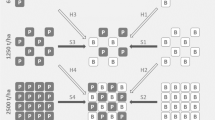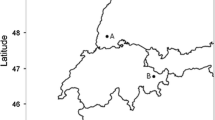Abstract
The effect of mixture on productivity has been widely studied for applications related to agriculture but results in forestry are scarce due to the difficulty of conducting experiments. Using a modeling approach, we analyzed the effect of mixture on the productivity of forest stands composed of sessile oak and Scots pine. To determine whether mixture had a positive effect on productivity and if there was an optimum mixing proportion, we used an aggregation technique involving a mean-field approximation to analyze a distance-dependent individual-based model. We conducted a local sensitivity analysis to identify the factors that influenced the results the most. Our model made it possible to predict the species proportion where productivity peaks. This indicates that transgressive over-yielding can occur in these stands and suggests that the two species are complementary. For the studied growth period, mixture does have a positive effect on the productivity of oak-pine stands. Depending on the plot, the optimum species proportion ranges from 38 to 74% of oak and the gain in productivity compared to the current mixture is 2.2% on average. The optimum mixing proportion mainly depends on parameters concerning intra-specific oak competition and yet, intra-specific competition higher than inter-specific competition was not sufficient to ensure over-yielding in these stands. Our work also shows how results obtained for individual tree growth may provide information on the productivity of the whole stand. This approach could help us to better understand the link between productivity, stand characteristics, and species growth parameters in mixed forests.




Similar content being viewed by others
References
Balandier P, Sonohat G, Sinoquet H, Varlet-Grancher C, Dumas Y (2006) Characterisation, prediction and relationships between different wavebands of solar radiation transmitted in the understorey of even-aged oak (Quercus petraea, Q-robur) stands. Trees Struct Funct 20:363–370
Biging GS, Dobbertin M (1992) A comparison of distance-dependent competition measures for height and basal area growth of individual conifer trees. For Sci 38:695–720
Brown AHF (1992) Functioning of mixed-species stands at Gisburn, N.W. England. In: Cannell MGR, Malcolm DC, Robertson PA (eds) The ecology of mixed-species stands of trees. Blackwell Scientific Publications, Oxford, pp 125–150
Canham CD, LePage PT, Coates KD (2004) A neighborhood analysis of canopy tree competition: effects of shading versus crowding. Can J For Res 34:778–787
Cressie NAC (1993) Statistics for spatial data. Wiley, New York
de Wit CT (1960) On competition. Institute for Biological and Chemical Research on Field Crops and Herbage, Wageningen, Netherlands
del Rio M, Sterba H (2009) Comparing volume growth in pure and mixed stands of Pinus sylvestris and Quercus pyrenaica. Ann For Sci 66:502p501–502p511
Dieckmann U, Law R, Metz JAJ (2000) The geometry of ecological interactions: simplifying spatial complexity. Cambridge University Press, Cambridge
Garber SM, Maguire DA (2004) Stand productivity and development in two mixed-species spacing trials in the central Oregon cascades. For Sci 50:92–105
Harper JL (1977) Population biology of plants. Academic Press, London
Hart SP, Marshall DJ (2009) Spatial arrangement affects population dynamics and competition independent of community composition. Ecology 90:1485–1491
Hector A (2006) Overyielding and stable species coexistence. New Phytol 172:1–3
Hector A et al (1999) Plant diversity and productivity experiments in European grasslands. Science 286:1123–1127
Hector A, Bazeley-White E, Loreau M, Otway S, Schmid B (2002) Overyielding in grassland communities: testing the sampling effect hypothesis with replicated biodiversity experiments. Ecol Lett 5:502–511
Hooper DU et al (2005) Effects of biodiversity on ecosystem functioning: a consensus of current knowledge. Ecol Monogr 75:3–35
Illian J, Penttinen A, Stoyan H, Stoyan D (2008) Statistical analysis and modelling of spatial point patterns. Wiley, Chichester
Ishii H, Asano S (2010) The role of crown architecture, leaf phenology and photosynthetic activity in promoting complementary use of light among coexisting species in temperate forests. Ecol Res 25:715–722
Ishii HT, Tanabe S, Hiura T (2004) Exploring the relationships among canopy structure, stand productivity, and biodiversity of temperature forest ecosystems. For Sci 50:342–355
Jolliffe PA (2000) The replacement series. J Ecol 88:371–385
Kelty MJ (2006) The role of species mixtures in plantation forestry. Improving productivity in mixed-species plantations. For Ecol Manag 233:195–204
Kelty MJ, Larson BC (1992) The ecology of silviculture of mixed species forest. Kluwer Academic Publishers, Dordrecht
Levin SA, Pacala SW (1997) Theories of simplification and scaling of spatially distributed processes. In: Tilman D, Kareiva P (eds) Spatial ecology: the role of space in population dynamics and interspecific interactions. Princeton University Press, Princeton, pp 271–295
Loreau M (2004) Does functional redundancy exist? Oikos 104:606–611
Loreau M et al (2001) Ecology—biodiversity and ecosystem functioning: current knowledge and future challenges. Science 294:804–808
Loreau M, Naeem S, Inchausti P (2002) Biodiversity and ecosystem functioning: synthesis and perspectives. Oxford University Press, Oxford
Lotwick HW, Silverman BW (1982) Methods for analysing spatial processes of several types of points. J Royal Stat Soc B 44:406–413
Luis JFS, Monteiro MD (1998) Dynamics of a broadleaved (Castanea sativa) conifer (Pseudotsuga menziesii) mixed stands in northern Portugal. For Ecol Manag 107:183–190
MCPFE, UNECE, FAO (2007) State of Europe’s forests 2007. MCPFE, Warsaw
Morneau F, Duprez C, Hervé JC (2008) Les forêts mélangées en France métropolotaine. Caractérisation à partir des résultats de l’Inventaire Forestier National. Revue Forestiere Francaise LX:107–120
Ngo Bieng MA, Ginisty C, Goreaud F, Perot T (2006) A first typology of Oak and Scots pine mixed stands in the Orleans forest (France), based on the canopy spatial structure. N Z J Forest Sci 36:325–346
Niinemets U, Valladares F (2006) Tolerance to shade, drought, and waterlogging of temperate northern hemisphere trees and shrubs. Ecol Monogr 76:521–547
Perot T, Goreaud F, Ginisty C, Dhote JF (2010) A model bridging distance-dependent and distance-independent tree models to simulate the growth of mixed forests. Ann For Sci 67:502p1–502p11
Picard N, Franc A (2001) Aggregation of an individual-based space-dependent model of forest dynamics into distribution-based and space-independent models. Ecol Modell 145:69–84
Piotto D (2008) A meta-analysis comparing tree growth in monocultures and mixed plantations. For Ecol Manag 255:781–786
Pretzsch H (2005) Diversity and productivity in forests: evidence from long-term experimental plots. For Divers Funct Temp Boreal Syst 176:41–64
Pretzsch H (2009) Forest dynamics, growth and yield: from measurement to model. Springer, Berlin Heidelberg New York
Pretzsch H, Schutze G (2009) Transgressive overyielding in mixed compared with pure stands of Norway spruce and European beech in Central Europe: evidence on stand level and explanation on individual tree level. Eur J Forest Res 128:183–204
Ripley BD (1977) Modelling spatial patterns. J Royal Stat Soc B 39:172–212
Schmid B, Hector A, Saha P, Loreau M (2008) Biodiversity effects and transgressive overyielding. J Plant Ecol Uk 1:95–102
Sonohat G, Balandier P, Ruchaud F (2004) Predicting solar radiation transmittance in the understory of even-aged coniferous stands in temperate forests. Ann For Sci 61:629–641
Stadt KJ, Huston C, Coates KD, Feng Z, Dale MRT, Lieffers VJ (2007) Evaluation of competition and light estimation indices for predicting diameter growth in mature boreal mixed forests. Ann For Sci 64:477–490
Thebault E, Loreau M (2006) The relationship between biodiversity and ecosystem functioning in food webs. Ecol Res 21:17–25
Tilman D, Reich PB, Knops J, Wedin D, Mielke T, Lehman C (2001) Diversity and productivity in a long-term grassland experiment. Science 294:843–845
Uriarte M, Condit R, Canham CD, Hubbell SP (2004) A spatially explicit model of sapling growth in a tropical forest: does the identity of neighbours matter? J Ecol 92:348–360
Vandermeer J (1989) The ecology of intercropping. Cambridge University Press, Cambridge
Vila M, Vayreda J, Comas L, Ibanez JJ, Mata T, Obon B (2007) Species richness and wood production: a positive association in Mediterranean forests. Ecol Lett 10:241–250
Acknowledgments
This work forms part of the PhD traineeship of T. Perot and was funded in part by the research department of the French National Forest Office. We are grateful to the Loiret agency of the National Forest Office for allowing us to install the experimental sites in the Orleans state forest. Many thanks to the Cemagref staff at Nogent-sur-Vernisson who helped collect the data.
Author information
Authors and Affiliations
Corresponding author
Appendices
Appendix
Aggregating the distance-independent individual-based model
Given a distance-independent individual-based model:
where Δr i,j is the radial increment of a tree i belonging to a species j between time t and time t + Δt, girth i,j is the girth at time t for a tree i. Starting from Eq. (11), we can develop a stand model for species j using an aggregation approach. The stand can be defined with three aggregated variables for each species: the number of trees N j , the mean radius \( \bar{r}_{j} \) and the basal area G j . The dynamic equations of these variables must be defined using Eq. (11). Since we assume that there is neither mortality nor recruitment between t and t + Δt, we have \( \Updelta N_{j} = 0 \). The mean radius is defined as follows:
where \( \bar{r}_{j} (t) \) is the mean radius at time t. The mean radius increment can thus be written as a function of the individual radial increments:
It follows from Eq. (11) that:
And the mean radius increment is given by:
Similarly, ΔG j can be written as a function of the individual basal area increments (\( \Updelta g_{i,j} \)):
where g i,j is the basal area of a tree i and \( \Updelta g_{i,j} = g_{i,j} (t + \Updelta t) - g_{i,j} (t) \). Since \( g_{i,j} (t) = \pi (r_{i,j} (t))^{2} \) we can write \( g_{i,j} (t + \Updelta t) \) as a function of \( r_{i,j} (t) \), \( r_{i,j} (t + \Updelta t) \) and \( \Updelta r_{i,j} \):
Therefore:
It follows from Eq. 11 that:
and
We can now express the individual basal area increment as a function of \( r_{i,j} (t) \), \( g_{i,j} (t) \) and the parameters of Eq. (11):
Since \( \sum\nolimits_{i = 1}^{{N_{j} }} 1 = N_{j} \), \( \sum\nolimits_{i = 1}^{{N_{j} }} {r_{i,j} } = N_{j} \bar{r}_{j} (t) \) and \( \sum\nolimits_{i = 1}^{{N_{j} }} {g_{i,j} } = G_{j} (t) \), we can sum the individual basal area increments to obtain the stand basal area increment:
Therefore, the system of equations for the stand model is:
Optimum mixing proportion
Since \( \Updelta G^{\prime}(x) \) is a polynomial equation of the second degree, its roots are:\( x_{1} = \frac{{ - b - \sqrt {b^{2} - 4ac} }}{2a} \) and \( x_{2} = \frac{{ - b + \sqrt {b^{2} - 4ac} }}{2a} \)
The table below shows that for the nine plots, a is always positive so the function \( \Updelta G^{\prime}(x) \) is convex. It is negative between x 1 and x 2 and positive for x < x 1 et x > x 2. x 1 is thus a maximum for the function \( \Updelta G(x) \).
Coefficients and roots of \( \Updelta G^{\prime}(x) \) for the nine plots.
Plot | a | b | c | x 1 | x 2 |
|---|---|---|---|---|---|
D02 | 1493 | −64785 | 37871 | 0.593 | 43 |
D108 | 14688 | −168693 | 69966 | 0.431 | 11 |
D20 | 15403 | −172769 | 62590 | 0.375 | 11 |
D27 | 6466 | −83284 | 37311 | 0.465 | 12 |
D42 | 5225 | −74980 | 33143 | 0.457 | 14 |
D49 | 13152 | −185208 | 82799 | 0.462 | 14 |
D534 | 9357 | −102027 | 40109 | 0.408 | 10 |
D563 | 268 | −31239 | 22837 | 0.736 | 116 |
D78 | 5457 | −95660 | 52986 | 0.573 | 17 |
About this article
Cite this article
Perot, T., Picard, N. Mixture enhances productivity in a two-species forest: evidence from a modeling approach. Ecol Res 27, 83–94 (2012). https://doi.org/10.1007/s11284-011-0873-9
Received:
Accepted:
Published:
Issue Date:
DOI: https://doi.org/10.1007/s11284-011-0873-9




